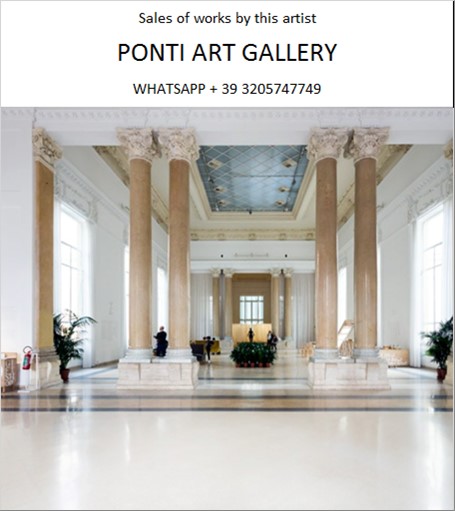Ponti Art Gallery is interested in buying and selling works
of art by this artist.

Jean Dubuffet Biography
Jean Philippe Arthur Dubuffet, born on July 31, 1901, in Le Havre, France, emerged as one of the most influential French artists of the 20th century, known for his development of Art Brut and his profound impact on post-war art. Dubuffet's journey into the art world was unconventional, marked by periods of withdrawal and re-engagement with painting, which ultimately led to a rich and diverse body of work that challenged conventional notions of beauty and artistic creation.
Dubuffet's early life in Le Havre was within a bourgeois family of wine merchants, providing him a comfortable upbringing. Despite this, Dubuffet demonstrated a rebellious streak against authoritative and conventional paths from a young age. His initial foray into the art world began when he moved to Paris in 1918 to study at the Académie Julian. However, finding the academic training distasteful, Dubuffet left after six months to pursue independent studies, developing interests in music, poetry, and languages, and traveling to Italy and Brazil.
The interwar years saw Dubuffet oscillating between art and the family wine business. He first abandoned painting in 1924, only to return to it briefly in the mid-1930s, and then again more seriously in 1942. This period of re-engagement marked the beginning of Dubuffet's lifelong exploration of Art Brut, or "raw art," a term he coined to describe art created outside the boundaries of official culture; art by the mentally ill, prisoners, and children, which he believed was more authentic and untainted by cultural and artistic conventions.
Dubuffet's work from the 1940s onwards was characterized by a radical departure from traditional aesthetics. He incorporated unconventional materials such as tar, gravel, and sand into his paintings, creating textured, gritty surfaces that served as a visual protest against refined art. His figures and landscapes, often rendered in a crude, childlike manner, challenged societal norms of beauty and sophistication. Dubuffet's art was not just a visual experience but an ideological statement that sought to democratize the creation and appreciation of art.
The post-war period was a time of prolific output for Dubuffet. He delved into various mediums, including painting, sculpture, and printmaking, and his work became increasingly experimental. The 1960s saw the development of his Hourloupe cycle, a series characterized by interlocking cellular shapes filled with vibrant colors, which Dubuffet later expanded into large-scale sculptures and architectural installations. This period also marked Dubuffet's engagement with public art, creating works that interacted with urban spaces and the public in novel ways.
Dubuffet's influence extended beyond his own creations. He was a passionate collector of Art Brut, amassing a significant collection that he eventually housed in the Collection de l'Art Brut in Lausanne, Switzerland. Through his advocacy, Dubuffet played a crucial role in bringing the work of outsider artists to a broader audience, challenging the art world's hierarchies and expanding the definition of what could be considered art.
Throughout his career, Dubuffet remained a provocateur, constantly questioning and subverting artistic conventions. His work was both a reflection of and a reaction to the tumultuous times he lived through, from the devastation of World War II to the cultural shifts of the 1960s and beyond. Dubuffet's legacy is not just in the artworks he left behind but in his enduring impact on contemporary art, inspiring generations of artists to explore beyond the boundaries of traditional art-making.
Jean Dubuffet passed away on May 12, 1985, in Paris, but his work continues to be celebrated worldwide for its radical approach and its challenge to the art establishment. Dubuffet's art brut philosophy has influenced countless artists, including notable figures like Jean-Michel Basquiat and Keith Haring, and remains a vital part of discussions around the inclusivity and scope of artistic expression. Through his defiance of conventional aesthetics and his championing of raw, unfiltered creativity, Dubuffet has secured his place as a pivotal figure in the history of modern art.
Jean Dubuffet Quotes and Sales
of Works
Ponti Art Gallery selects and deals with paintings by the
artist. Upon request, we provide free estimates and
evaluations, communicate prices, quotations, and current
market values.
If you are interested in BUYING or SELLING works by the
artist, contact us immediately.
If you wish to sell or receive an evaluation of the
works:
Send us a frontal photo of the painting, one of the back,
and one of the signature. Also, indicate the dimensions of
the work. Inform us about the purchase origin of the work
and any kind of available documentation (purchase
receipts, certificates of authenticity, publications). One
of our operators will respond to you on the same day. We
guarantee maximum confidentiality and extreme
professionalism.
If you wish to purchase works by the painter: Contact us
and let us know your request. We will inform you about the
available works. We also offer the possibility to
subscribe to our NEWSLETTER, through which you will be
informed at the beginning of each month about the latest
acquisitions of the art gallery.
You can send us pictures of the work:
